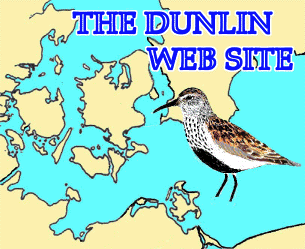
the Dunlin Website!
Comments and fresh links:
- 16.2.11: I am working hard on my webpage about the Dublin Brent: A city, a goose. Dublin and its wild geese, the first text was uploaded today. (The domain name is www.dublinbrent.se). There will be subdivisions: one strictly ornithological, about Brent Geese, one about colour rings, sighting of colour rings, with a description of the Irish/Icelandic colour ringing project, one about urban ecology from the horizon of Dublin. Much to do, i won't be finished by midsummer! [CP]
- 7.1.11: A few recent recoveries, just to mark my presence:
Redpoll, controlled 1c female, Ljunghusen 21.11.10 - ringed 1c Ammarnäs, Lycksele lappmark Sweden 6.8.10; 1186 km S.
Pochard, ringed 3c+ male, Falsterbokanalen 2.3.96 - shot Ustrem, Khanty-Mansi, RUSSIA "2 years ago" according to letter 27.9.10. 2994 km NE.
And a recovery reminding us that the local Phylloscopus collybita collybita do actually arrive at breeding quarters in late March and maybe don't migrate that far: Chiffchaff, ringed 1c Ljunghusen 23.8.09 - controlled Greifswalder Oie, Mecklenburg-Vorpommern, GERMANY 23.3.10. 143 kms SSE.
- 7.11.10: The picture below was made more than twenty years ago, it is intended as a reminder to the Falsterbo Bird Observatory, messing with bird protection in the Flommen area of the peninsula for some forty years or so. [CP]

- 7.11.10: Few Dunlins migrating by way of the Öresund area this autumn, just one wave - but i have experienced such autumns before. They must be endured, there are better years to come. New picture from Taiwan on the Dunlin Website. Note the alternative address of Fågelstudier on Surftown. [CP]
- 9.9.10: Today i start getting my different web pages together on Surftown, and for a year or so they will be available on two addresses. Fågelstudier has been lying close to its maximum limit, 10 MB, for a couple of years now, in the future i will have 20 GB to play with. I can publish fine-grain Dunlin pics on the Dunlin Website, no more compromises! At the same time i will trim the contents and start working on a couple of new contributions, the first one a subsite dedicated to the Brent Geese in Dublin. Tree Pipit, Little Tern and a couple of moult papers will get a new layout and a text overhaul. Some outdated items will be erased. The new address - Fågelstudier at Surftown - will appear in the header of the page when the transfer is complete, as a reminder. [CP]
- 9.9.10: Polish Dunlins carrying white rings with black text: letter + 2 numerals, the project coming off in 2010, initiated by WRG Kuling. In Germany the first sightings caused some initial bewilderment and groaning: not another anonymous project! The information seems to be in place by now, however. [CP]
- 24.8.10: The Whimbrel campaign on the heath of Skanör (Falsterbo peninsula) is over, in a summer of prolonged, severe drought, when most crowberry stands shed their berries. As a consequence the Whimbrels foraged mainly on the watered golf-course, feeding on earthworms, and were fairly easy to observe. I caught 21 adult and 2 juvenile Whimbrels, in addition 12 juvenile Curlews and 3 adult Bar-tailed Godwits, the best combined result ever. (Numenii are too intelligent to allow more than 3 - 4 effective catches per annum, and the astronomical parameters - luminous clouds, Nordic bright night, one or two full moons - are inimical to good nocturnal catch in July and early August). The maximum flock comprised some 130 - 140 Whimbrels shortly before mid-July, but i dare say that at least twice as many visited the site this summer. In crowberry years the maximum number by mid-July will exceed 200 and the overall annual sum will be accordingly higher. The first birds appear from ca. 45 minutes before sunrise, all birds present depart by 06h, when the work-force of the course arrives. The early birds, from 4 o'clock by midsummer, start foraging on both sides of the machine-station (eastern parts of course), in particular along the fairway up to hole 19, where an observer can hide in several stands of pine. The main flock abandons the western parts of the course when the first mowers appear there shortly after 06h. Because of this, effective ring-reading and general observation must be done between 05h and 06h (dark colours like blue, black, green, brown are difficult to discern before sunrise). In 2010 i sighted 9 colour-ringed Whimbrels from earlier years, another two couldn't be identified with certainty. In addition i had 12 sightings of birds ringed in 2010, from 3 hours to c3 weeks after ringing. A couple of one-legged birds, probably wounded by French or African hunters, were observed, furthermore quite a lot of birds with Swedish steel-rings (i have ringed ca. one dozen in each year since 1997, the first colour-rings applied in 2002) and one or several with worn, rather large (larger than Swedish "8") aluminium rings. A bird with hudsonicus characters (probably ringed, possibly by me on 25 July 1999) was observed in the flock several times in July, a deviant, very shy bird seen at a great distance on a couple of occasions in August was first thought to be a leucistic Numenius phaeopus; i didn't come to think of Numenius tenuirostris until after it had left. In hindsight: its general impression was much like Arnoud van den Berg's birds in "Photographic Guide to the Waders of the World". The problem is that i don't give a damn about rara aves, i avoid them actively, only, i wish i had been up on my toes in this particular case. Well, maybe it will be there for all to see next year again! Both Whimbrel (only one sighting of colour-rings from the public in eight years) - and most certainly Slender-billed - are very evasive, one has to use a hide, be there before them, or one won't come near. The identification isn't unproblematic either: Druridge Bay curlew and Bird Guides, and there are even doubts as to the species status of the Slender-billed Curlew; could it be a recurring product of a failure/breakdown of the adaptive radiation of Curlew and Whimbrel in Central Asia? [CP]
- 14.8.10: New picture added to the Dunlin Website. And a new Greenshank weighing 227 gs.; maybe i should check my old Pesola. [CP]
- 9.5.10: The lowest weight of Greenshanks on Falsterbo peninsula is appr. 127 g, i have had several birds with that weight. The three heaviest ones in July/Augusti weighed almost twice as much: 227, 243 and 268 g, such weights are caused by the Greenshank's capacity for Gargantuan feeding. Today i took a spring bird weighing 227 g, and i could feel that it had a substantial fat store. In autumn confined small fish mostly lies behind such increases; the shanks just gorge themselves till they are extended like balls. This is the reason why Greenshanks are fairly numerous at the Spits of Skanör when the wind flats emerge. Moreau noted that Tringa species in Africa often occur in the last phases of dessication, where the surface water is disappearing; again small pools with confined prey is the reason. The Green Sandpiper shares the ability of the Greenshank in such situations, often doubling its weight where small fish becomes available. [CP]
- 30.4.10: "From the bird's calendar": It's interesting to note how local warbler females are pushing their schedule this year, it's not only the males. Today a Willow Warbler male ringed on April 23rd last spring hung in the net next to a female ringed on May 10th, also last spring; Walpurgis is early for a Willow Warbler female! And the local Lesser Whitethroat male, ringed at Falsterbo 28.4 last spring, had two interested females in his territory as far as i could see.
Why do the Finns have Southern Dunlin and Little Tern on their side of the Bothnian Gulf, while the Swedes have nothing? The exception is probably Haparanda Sandskär, i guess habitat types are involved. Birds from the Finnish schinzii population are still migrating; at dawn today i took a 3c+ male from the Oulu area (1y, Lumijoki, just south of Oulu, 3 June 2008), this bird still has 1000 kms ahead of it. I guess one sees more migrant than local schinzii in April in Southern Scania these days, and the reason of course is that we have mismanaged our major reserves: Flommen, Vellinge and Eskilstorp's meadows, for some thirty years or so. In Vellinge the major problem is the reactionary municipal council, but it is assisted by the local petty-bourgeois twitchers, calling themselves ornithologists, but caring about little but rara aves. Because of this the Falsterbo Bird Observatory is also part of the problem, always was; it would have been wise to keep the station crew out of conservancy projects from the very start. (I am glad for the new Eskilstorps project, linking up where Paul-Eric Jönsson once let go, but i think it comes too late, Scanian schinzii stand at the precipice).
In contrast to the tiny schinzii male i also took a large alpina female - still European, i bet twenty quid on Novaja Semlja longitude for that bird - in full winter plumage, which means that she had at least twenty days of body moult ahead of her! For this she obviously "expects" to find enough food in the Baltic - or? I catch one or a few of these odd individuals each spring; could they have crossed the Continent from S or SSE and be heading for the Waddensea? If this is a regular pattern, most of them are likely to do the crossing non-stop; these Curlew Sandpiper-large Dunlin fly 1500 kms easy as that. She weighed 64 g (with wing 126 mm) - which could be a migration weight or post-migration weight, even with that wing. So, she might have had another 500 kms left to fly, crossing the tracks of that schinzii male almost at a right angle... Oh, there is always something new and unexpected to detect! [CP]
- 3.10.09: The windy weather throws a spanner into all attempts to catch with nets in the autumn of 2009, but last night i got a few working hours with Dunlin. Again western birds were dominating (showing that there aren't distinct "waves" but rather migrating populations interlocking into each other, released by different weather events, to the north and the east). I sat with the impression that the surrounding movement was released by falling temperatures, it went on at a steady pace till the front entered and the wind grew at dawn. The birds weren't tired, probably coming from rather nearby resting areas. The shortest bill measured 26,8 mm, median coverts of the wing were white- and grey-edged, wind-torn, i have seen quite a few of those before. I don't even know the schedule of Karelian and Norwegian schinzii; do they not migrate earlier, in August? I must visit the museum again. It's a peculiar phenomenon: the most short-billed and the most long-winged "pools" of my ringing material both have zero recovery rates, are gone with the wind, don't even re-emerge as adults. Which tells us that they are marginal, spice to the everyday alpina stew. [CP]
- 26.9.09: And ten days later the Siberians make up almost 50 % of the flocks. Some of them are real beasts, with wing-lengths between 127 and 130 mm and weights quickly heading for 75 g; they still have a long journey ahead of them. Oh, how i wish there was someone at the target, capable of catching Dunlin! I lose them out of sight, have few clues as to where they go. My guess is something southeasterly, maybe Egypt, maybe Algeria, Tunisia, Libya first. Still they might first extend the migration loop even more to the west; i don't exclude that these birds migrate down la Manche and cross southern France in order to enter the Mediterranean (see recoveries under "D" in the recovery collection of the Dunlin Website). Mallorca, Menorca, Sardegna could be stations on the continued journey. [CP]
- 16.9.09: I have had a hunch for some time now that arctica juveniles participate in the first wave of juvenile Dunlin migration by way of the Öresund area in September, only: many of them can't be determined beyond doubt because of the overlap between subspecies in measurements. Why not Greenland/Svalbard Dunlin when Iceland Redshanks and Black-tailed Godwits visit our area regularly ? Last night i took a juvenile with bill-length 23.8 mm, however, a short-billed arctica male. A retrap of a bird with Finnish ring indicated the proximate way of approach, and out of 95 Dunlin caught some 88 were plain western alpina. I'm still waiting for the big flocks where Siberians make up the majority; the Westerners had passed on already on 17 September. [CP]
- 9.9.09:
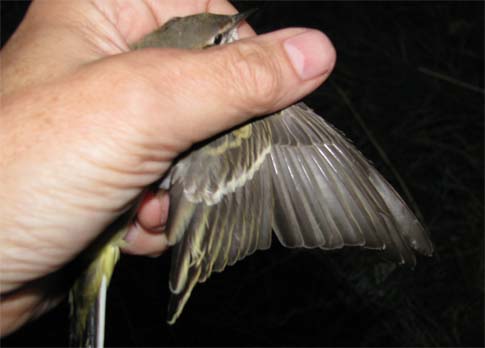
Something citrine wagtailish: a whitish yoke at the bill base, black bill, but a slight yellowish tinge to under tail coverts. I think: maybe hybrid flava/citreola rather than pure citreola. Lousy picture; i was in a hurry, didn't have the time to make a decent camera job. [CP]
- 9.9.09:

Two Yellow Wagtails of northern provenance, early September, the one to the right "pure" thunbergi type, without eye-stripe, the one to the left with some flava infiltration. A lot of Norwegian Yellow Wagtails migrate by way of Southern Scania; Sammalisto (1958) found that the frequency of intergrades equalled the frequency of pure thunbergi in some parts of Norway, and i believe that the dominance of intergrades in the South Swedish material has its origin there. According to Vepsäläinen (1968) the integrade meets pure thunbergi "at the abrupt macroclimatic border between South and North Finland in Tornio - Kainuu (appr. the diagonal 66° - 64°30' N; CP). (...) The intergrading zone is very narrow, between 10 - 20 km from south to north." Note that these birds have no black on cap or forehead in winter plumage, one has to look twice in order to detect a white line between bill and throat. The more or less stabilised intergrades/transitional birds always have more saturated colours; more olivaceous edges to feathers, more of brown pigment, and the crop band may be quite prominent. [CP]
- 5.9.09: Added to the literature list of the Dunlin Website today:
Meissner, W. & M. Skakuj (2009): Ageing and sexing the Dunlin Calidris alpina. WSGB 116: 35 -38.
CP: A sloppy paper that disgraces authors and referee. Meissner belongs to the authors using references as ornaments, he quotes in order to magnify himself, and often quotes contrary to his own conviction or experience. In contrast to Jadwiga Gromadzka he seldom quotes Russian workers, nor does he seem to have open channels to Gromadzka herself, there is a rift in Polish ornithology. As a person he reflects contemporary Poland, striving for international recognition, a position in the world. His strong side is his access to a wealth of Polish field material - and i myself owe a debt of gratitude to him - but as a scientist he is conventional, commonplace, lacks courage. Both Meissner and Clark are well aware of the existence of the Dunlin website, and they both know that the material presented there outshines anything printed on the matter in Europe - in particular within the framework of the WSG - but they are too vain or too prejudiced to refer to it! The paper illustrates how the WSG has become a bloodless club for "internal/mutual admiration". I will concentrate my criticism on Meissner's quotation technique, which has annoyed me for quite some time now, and in order to restrict the polemics i will mention four initial points only:
1. Meissner tells us: Currently nine subspecies are recognized, which differ in size and in the colour of the upperparts in breeding plumage (del Hoyo et af. 1996). Why are we fed with this information to some "Handbook of the Birds of the World" - as if these obscure handbooks have the essential or original thing to say about supspecific division in Dunlin? Why not e.g. Engelmoor and Rosselaar 1998, or some journal paper, which have much more to add on this point? I hate this type of vanity quotation, it's so meaningless.
2. Next line: there is evidence that shows that some birds may originate from as far east as the Taimyr Peninsula, again a pompous and vague statement without the most modern and relevant reference. Why not for example Tomkovich, Lappo and Syroechkovskij (2000), a paper that lists the existing recoveries from Taimyr up till that year, and in a sense tells us: "non plus ultra"? I am often struck by the feeling that Meissner consequently gives the second or third best reference!
3. Meissner knows that there is a substantial late autumn migration of adult Dunlin in the Baltic, and he should know from Polish recoveries that the individual moult and migration strategy may shift between years (choice between the Black Sea and the Baltic, migration flight on unmoulted or moulted wing), still he prefers to quote himself out of the moult dilemma by referring to the nonsensical and catastrophic Holmgren papers: Some individuals start replacing primaries during incubation in June (Holmgren et al. 2001), while others begin replacing body feathers and inner primaries during migration, on moulting areas or on the wintering grounds. Primary moult is not usually arrested during migration (Holmgren et al. 1993). What has been written about moult based on Ottenby material is utterly confused and misleading; the orthodox Darwinist point of departure makes Holmgren et co-authors miss all relevant points. And Meissner himself, not corrected by the referee Nigel Clark, writes "arrested" where he by all likelihood intends to say "suspended", an old and recurring error by authors who are not at ease with moult materials and moult terminology.
4. When it comes to the time schedule of birds with "adult buff" coverts, Meissner is happy to quote himself: On the Polish Baltic coast these birds occur more numerously from mid-September, whereas in the Adriatic they appear from the beginning of September (Meissner et at. 2005). This is totally incomprehensible to me, since the first migrants with "adult buff" occur in the Öresund area from 10 July - a parallel to the regular migrations of Curlew Sandpipers from the Taimyr by the same time - and the culmination falls shortly after 1 August. There is a moult diagram, based exclusively on Dunlin with "adult buff" medians in the original moult paper, and there are pictures of birds with fresh adult buff medians already from 17 July in the picture collection. I know from the visitors' addresses that readers from Meissner's and Clark's institutions have visited and studied my website, but obviously to little avail. They could even have asked me for help, and i would have saved them from the worst pitfalls. I forward as a hypothesis: Meissner and Clark are too vain or too prejudiced to quote from material that could have improved and corrected this muddled, inferior paper. Their failure in turn also shames the Wader Study Group.
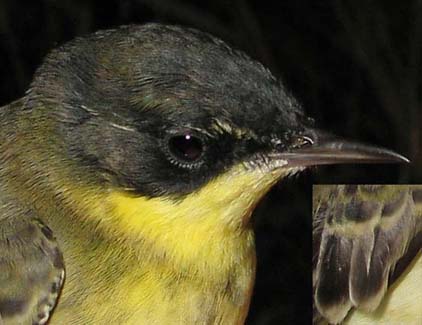
Something of eastern provenance in the Yellow Wagtail complex, by all likelihood not a "thoroughbred" type: dombrowskii, melanogrisea, or feldegg, maybe a gene of cinereocapilla. The plumage is entirely fresh (21.8), the black of the head partly covered by olive edges. The throat has a yellowish hue, no more. Greater and median coverts are shown at the lower right corner, in the subspecies mentioned they form two broad wing-bands, in the present case neither of them as yellow as in spring plumage. (On 2 September i have studied half a dozen male thunbergi, all had this pale wingband and pale yellow almost to the bill. But they all had black only on ear coverts and dark slate-grey crown in winter plumage. I am in no way certain of this bird; maybe a very black thunbergi). [CP]
- 29.7.09: Two new pics added to the Dunlin pics of the Dunlin Website and one new to sexing and ageing of waders. Very strong arrival of Dunlin in the morning of 27 July; the nocturnal catch was a failure because of unfavourable wind and water levels, but i managed to catch a few in daylight in the dense arrival after five o'clock (small flocks arriving - after crossing the heath! - every ten seconds; these birds obviously cross Skåne diagonally, exiting between Klagshamn and Eskilstorp, passing the northern piers of the Falsterbo Canal and entering the heath by way of the clearing at Gyeholmen). I tremble a little before this parade, imagining that i see a millenium-old "flyway", transferred from generation to generation. As a small bonus for my diligence i got a Dunlin on "migrants' low jets moult" from 22.7 today - it takes a bit of luck to get such data, there are years between them. [CP]
- 16.7.09: Calidris alpina schinzii has the same pattern of moult as Calidris alpina alpina; some starting to moult before departure. I have two fairly certain but long-winged birds in Migrating Dunlin Calidris alpina in the Baltic area: the moult issue, but today came a crystal-clear schinzii (2c male; wing length 105 mm, culmen 25,1 mm) from Skanör: it had shed P1 - 3, a short pin in P1. In all three cases P1 - 3 have been involved. [CP]

When rooting for crowberries the Whimbrel gets an unwelcome attachment: ticks. Note the very strong bill with spade-formed tip and the wide gap; in Africa this species opens and cuts up crabs on tidal beaches. (The shells are regurgitated; in order to dilute the salt content of the crab meat the birds make nocturnal excursions over the coastal Sahara, searching for freshwater). Feathers and skulls in the pellets show that large bird young are consumed as well (probably young of Meadow Pipit and Songlark, late summer breeders). Colour rings should be glued over a sufficient area, i think Whimbrels can prize open unglued colour rings with little effort. [CP]
- 15.7.09: Whimbrel, notes for the future: Don't combine black, brown, blue, green on one tarsus when giving a bird colour combinations, they may be difficult to separate in dawn light! It's best to combine one "bright" color with one dark, sightings are facilitated by contrast. E.g. i had some difficulty with blue over brown, couldn't see which ring was on top in dawn light with slight fog hanging over the ground. A day and an hour later there was no problem. [CP]
- 4.7.09: About the increasing persecution of Peregrines in the UK, from RSPB 1.7.09.
- 30.6.09: Three Whimbrels in Ljunghusen at dawn, but there are no crowberries for them (in spite of that i found a pellet, it probably flew here on wings). My appointing the climate "Atlantic" was quickly denied by high air pressure and easterly winds; when i go out in the early morning Quails are calling from the fields: "wet-me-lips", and along the south coast vagrant Black Kites are entering from the south. Reminding me: we stand with one foot in each camp. [CP]
- 18.6.09: "The Evil Eye of Golf" has been updated; right now it holds c135 links. "Invasive alien species" is being expanded.
- 17.6.09: Birdwatch Ireland's South Dublin branch has a series of to-the-point cuttings in its "News" section, many of them implying some knowledge of the particular Irish obstacles to a consequent environmental policy. Here I quote a more "cosmopolitan" cutting, aiming at the poor sods running round the nation after Melodious Warblers and Bluestarts: Serious birdwatchers are complete and total freaks, worthy of every stereotype that has been heaped on them, and then some. Whether they are American listers or British twitchers, they are a scary group of extremists. - Mike O'Connor, New Scientist 7.5.05. A pious addition: and Swedish "kryssare". [CP]

Roof-breeding Common Gulls at Skansen Museum in Stockholm.
- 17.6.09: The western Stonechats are breeding everywhere and my yews stretch themselves in the increasingly Atlantic climate. But rain and wind aren't equally attractive to all species; the Little Terns in the harbour of Trelleborg lost all twenty-five broods laid, on the gravel-banks of Eskilstorps Arctic Tern eggs were lying in a row along the water-edge, or rolled into Avocet nests (and these had most likely been flooded a couple of times). The Avocet herself is messing around in a characteristic way; abandoned egg-clutches in exposed positions, but new, equally precarious attempts are started at once. The Black-headed Gull lost some 5 - 10 % in the 24-hour-rain, the more exposed Common Gull (breeding on roofs) maybe 25%, i haven't checked the large gulls yet. [CP]
- 6.5.09: Note the three last pictures in the picture collection of The Dunlin website, a small stroke of luck. [CP]
- 21.12.08: With the new sub-header "Golf club bankruptcies" "The Evil Eye of Golf" has expanded to 119 links. "Invasive alien species" had doubled; 45 links [CP]
- 14.9.08: Moulting Grey Plovers + comment in sexing and ageing of waders on the Dunlin website.
- 4.9.08: Instructive pic of Svalbard Dunlin in the picture gallery of the Dunlin website.
- 4.8.08: Link to an Italian page with pictures of colour-ringed birds: Guida fotografica agli uccelli con anelli colorati/Photo-Guide to Colour-Ringed Birds.
- 30.7.08: Bengt Grandin reports a colour-ringed Whimbrel from Cape Nabben 23.7.08, it was ringed at Skanör 19.7.03, the oldest sighting so far of one of my colour-ringed birds. Marked birds occur with some frequency in flocks now, at dawn on July 12th i had several colour-ringed among more than 200 Whimbrels on the eastern parts of Ljunghusen golf-course (they always start here early in the morning, while the greens are still wet). Fog, condensation, too far away, i didn't have a chance to read them. Crowberries have failed almost completely because of the drought, in 2008 whimbrels stayed only for a few days and barely visited the heath, curlews also passed us by without resting. [CP]
- 18.4.08: Today we quote from The Arizona Republic: Stop building golf courses now! The religion of corporate America has enough cathedrals. [CP]
- 15.4.08: Link of the day is Dangerous assumptions, from Nature, 3 April 2008.
- 11.4.08: The three first link pages: "The Goat as Gardener in the Greenhouse: Capitalism Setting the Climate to Rights Again" (87 links), "The Evil Eye of Golf" (78 links) and "Wildlife Rehabilitation: Bleeding Hearts for God's Creatures" (40 links) are expanded at a cautious pace, they will gradually be split up into several documents. A fourth page is begun: "Invasive practices, invasive structures, invasive species", as a sort of paradigm for human influence on nature, i came upon this very significant article today: The Global Spread of GMO Crops. And even worse on the same topic: Escaped golf-course grass frees gene genie in the US. The new page takes much preparation and afterthought, it won't come immediately. Meanwhile i recommend a look every now and then at the link carbonify.com; carbon dioxide emissions accelerated in 2007, this is even more evident from the fresh link Carbon Dioxide Emissions Accelerating Rapidly from Earth Policy Institute 9.4.08. Still glowing hot is last week's ICES report Changes in surface CO2 and ocean pH in ICES shelf sea ecosystems. (Yes, i know: the energy cost for one Google inquiry is enough to power a low-energy bulb for one hour. We are all facing difficult moral choices). [CP]
- 31.1.08: Note the enormous expansion of sites listed under "Counts, global", on the Dunlin Website. When the global picture began to emerge i took out my abacus and did a few rough estimates. It's interesting to note how estimates tend to perpetuate themselves, repeated again and again by uncritical souls (the Swedish check-list suffers from a lot of antique furniture, too). It's much like in a restaurant: if you don't check the bill, you may get swindled. As far as i can see the estimate of the alpina population is fairly good, i doubt that many pacifica can avoid notice, and i dare not say anything about the Icelandic schinzii population. In all other cases the estimates deserve question-marks. There is a widespread tendency to stick to the upper limit of sakhalina and kistchinski estimates, 1 million, although the overall estimate for the East-Asian Flyway would add up if the lower estimate, 100,000, was used. And next: if the Russian populations are written down, the most recent estimate of the Alaskan arcticola population, 750,000, could be all wrong as well. Link errors (quite a few, caused by the partition of a folder into two) in "Risk-prone or risk-averse..." on the Dunlin Website have been corrected, too. [CP]
- 12.10.07: From Danmarks Miljöundersögelser The lowest number of cormorants for 15 years by Thomas Bregnballe. "Fågelstudier" was tracing this development among Cormorants more than a year ago, and by the same time the site www.dunlin.se published its pioneering Dunlin papers. But the requirements are great, Swedish ornithology is still weighed down by an improductive Darwinist yoke, and the level of papers is continuously sinking because of this. Next i will reduce the link collection, making it exclusively commenting and writing the comment in English, the freed space will be used for a couple of moult papers, written according to an orthodox model. It will take ten - fifteen years to establish a new standard for Swedish ornithology, but i can see and feel that i am on the right way. [CP]
- 8.10.07: Ringing dates for one Hungarian and one Ukrainian Dunlin control under "Recoveries" on www.dunlin.se. [CP]
- 24.9.07: Pictures of central tail-feathers in Little Stint and Red-necked Stint in ageing and sexing of waders. [CP]
- 6.8.07: Nine pictures brought together in the new folder for ageing and sexing of waders, some species will have to wait till i have a complete material. The Redshank pictures are the only interesting ones in the present collection. [CP]
- 25.7.07: Henning Behmann sent me a mail about a Redshank, ringed at Bottsand (Bay of Kiel) 30.8.98 - ring read at Gardur (66° 18'N, 16° 26' W), Iceland 19.6, 24.6.07, commenting: "I wasn't aware they were here already in August". But smatterofact the robusta reaches the south Baltic already by mid-July, and later on it may outnumber t. totanus at certain sites (summering 2y-birds in 2007, the explanation for early presence may lie here / Peter Olsson). The Iceland population must be huge, given the numbers in Ireland, Great Britain and Denmark; the birds seem to disperse in all directions due to some sort of "diffusion pressure"! I think we haven't seen the extreme limits of this dispersion yet, although the robusta seems to be maritime in its preferences. [CP]
- 15.7.07: Musikverlag Edition AMPLE is based in Germering, Germany, its home-page on www.ample.de and web address ample'at'ample.de. In the past it has published a.o. video films about the Imperial Eagle and Siebenbürgen as well as a sequence of instruction CD:s, among which I note Erich Kaiser: "Mauersegler gezielt ansiedeln" (How to make Swifts breed at your place), Michel Barataud "Fledermäuse" (Bats), Heiko Bellmann: "Heuschrecken" (Grasshoppers), Immo Tetzlaff: "Froschlurche" (Frogs) och Wolfgang Tins: "Walstimmen" (Whale voices). Recently came "The Bird Songs of Europe, North Africa and the Middle East", editor and publisher Andreas Schulze & Karl-Heinz Dingler, with 819 species included, 19:20 hours running time. A pdf document, providing English, French and German explanation, turns up on the screen while playing. Also see: www.birdsongs.de. I am reviewing this CD soon under a new header: "Reviews".
- 1.2.07: SMHI has an excellent article, "Long-lasting high water levels in the Baltic", the Swedish site obviously ogles the Danish DMI:s pedagogical, data-larded and quick site, but it's not equally good; when it comes to observations the SMHI site is less generous and more unwieldy. Before noon on February 1st there came a "reverse" wave from the Baltic, the water level rising to 1 meter above average level for the tenth time in a month in the Öresund area, flooding the whole shoreline and the marshland at Skanör, and central parts of the heath and the golf course of Ljunghusen. Streaming water washes the sand from the dunes, leaving the roots of stabilising plants bare. We will see more of this kind in a near future, and it should be remembered that the rising ocean is one reason why there should have been a ban on building on Falsterbo Peninsula twenty years ago. The commuting inhabitants of the peninsula are now harvesting their own CO2 emissions in the shape of rising water levels. [CP]
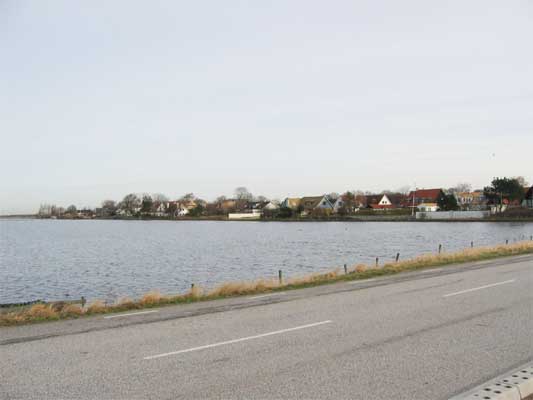
Skanör, facing the marshland, noon Feb. 1st 2007.
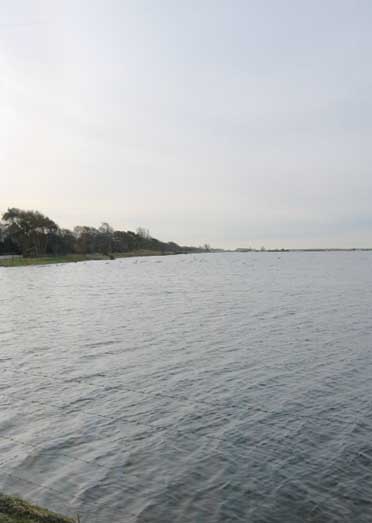
Skanör looking south toward Falsterbo 1.2.07; the future coastline.
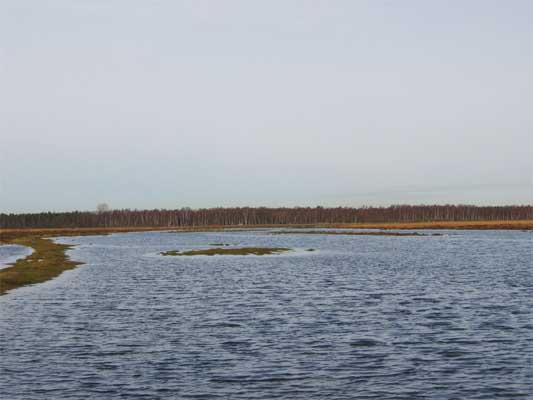
The heath, Ammarrännan 1.2.07; the Vikings are supposed to have pulled their ships across the peninsula along this "channel", the water level presumably being higher a thousand years ago.
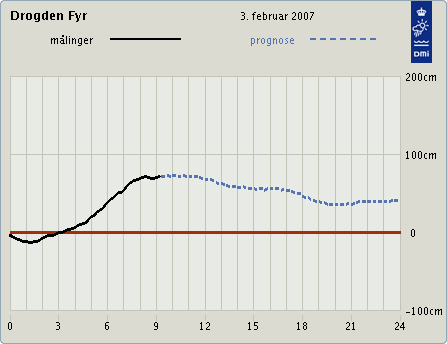
Data from DMI: water levels at Drogden, Öresund, 3.2.07; the water level rose 3/4 m. The dashed line shows the forecast. DMI:s forecasts could be better, they are not quick to consider expected changes in wind direction and wind force, offered by the global meteorological "public forum". Lousy models, but the Danes assure that they are working hard to improve them! [CP]
And here the IPCC report on climate development, short version for "decision-makers".
- 22.11.06: Note instructive pictures of Marsh and Reed Warblers from Ringmärkning på skånska sydkusten. [CP]
- 18.11.06: I intend gradually to build a folder in support of ageing of waders, apart from the Dunlin material already available at www.dunlin.se, the Turnstone is presented here as first species. The pictures were taken at Dun Laoghaire, south of Dublin, Ireland, 8 November 2006. [CP]
- 17.10.06: Goldcrest, female, ringed Stockholm RS0230, Ljunghusen 17.10.05, controlled at the ringing-site 17.10.06 (and the picture is taken on the later occasion). In "Key to sexing and ageing..." Busse (1984) contents himself with looking at the central rectrix, but that would be to no avail in this case. [CP]
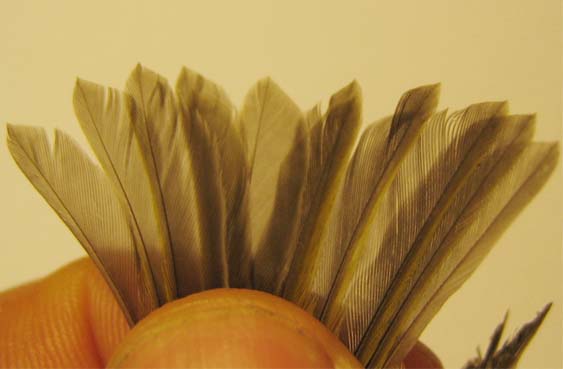
Appeals
Colour-ringed Whimbrels
Colour-ringed Dunlins
Papers on
standard form
e=English
s=Swedish
Emberiza schoeniclus Ie
Emberiza schoeniclus Is
Motacilla flava Ie
Phalacrocorax carbo Ie
Litteraturlistor
Riparia riparia
Motacilla flava
Dunlin, A-J
Dunlin, K-Z
Cormorant, A-M
Cormorant, N-Z
Waders, gen.
Energetics: A-K
Energetics: L-Z
Moult: A-F
Moult: G-M
Moult: N-R
Moult: S-Z
Links: climate
Links: golf
Links: rehab
Links: aliens